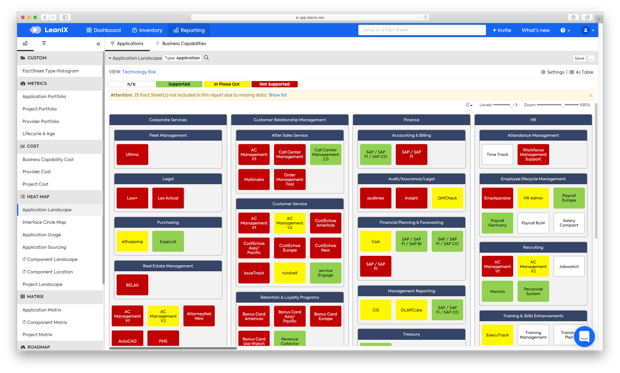
How does your business define “good” Enterprise Architecture?
Rainer Bartsch, Senior Enterprise Architect for RWE Supply & Trading, asked audiences this question during his presentation on “Application Harmonization using Design Principles in LeanIX” at LeanIX’s EA Connect Days—an annual conference of ideas and technologies related to the world of Enterprise Architecture.
For Bartsch and RWE, Enterprise Architecture programs only lead to effective change when directed by those with a clear idea of what’s best for their company’s IT. However, since “good” means different things to every stakeholder, how can Enterprise Architects distill a perfect combination of architectural targets out of a disarray of conflicting stakeholder opinions?
In what ways, Bartsch asks, can architectural decisions based on singular perspectives be transcended to refine, or “harmonize”, IT landscapes only according to what’s necessary for the enterprise to succeed—not just to help those shouting their demands the loudest?
His solution is an application inventory structured upon a single rationale: business value first. And to make sure every architectural adjustment and addition adheres to this core tenet, Bartsch demonstrates how he and RWE capitalized on the customization functionalities of LeanIX’s Enterprise Architecture Management tool to inventory and grade their IT portfolio against a criteria of ten IT “Design Principles”.
Design Principles for IT Portfolio Management
- Business value first; technology is the enabler
- Implement only one solution for each business capability
- Maintain single source-of-truth for shared business data
- Share information in a loosely coupled manner utilizing standard enterprise tools
- Prioritize cloud solutions where possible and appropriate
- Design for change, scalability, robustness and automation
- Maximize re-use and collaboration by providing well-defined services, interfaces and shared libraries
- Consider security and data protection as an integral part of each IT service
- Minimize complexity and conform to company-accepted standards
- Maintain system quality by utilizing appropriate documentation
In particular, Bartsch and RWE used two key customization functions of LeanIX to personalize their Application Portfolio Management efforts: Application Tagging and Fact Sheet Types.
Application Tagging
All applications in LeanIX can be inventoried according to attributes, or “Tags”, made by users themselves. Tagging is a way to label IT elements to add specificity during architectural campaigns and to broaden portfolio filtering, documentation and reporting potential. Categories of tags can be collected into groups and then used to generate configured perspectives of IT landscapes, and in the examples provided by Bartsch, the RWE Enterprise Architecture team made comprehensive tag groups for each of their ten design principles to aid in the process of evaluating applications.
Adding granularity to their design principles via tags (from “n/a” > “not met” > “partially met” > “fully met” > “valid exception”) gave RWE access to even more precise angles to examine their IT portfolio when using the LeanIX Application Landscape Report—an automated visual analysis of all technology connected to business processes. As such, they were able to mix and match their application quality assurance standards with some of the following built-in LeanIX analysis reports (available out-of-the-box to every user):
Functional Fit: A view of applications according to their corresponding Business Support (from Unreasonable to Insufficient to Appropriate to Perfect).
Technical Fit: A view of applications according to software or hardware graded for reliability and relevance (from Inappropriate > Unreasonable > Adequate > Fully Appropriate).
Data Classification: A view of applications according to the level of sensitive information being used, manipulated or utilized (from Public Unclassified > Sensitive > Restricted > Confidential).
Technology Risk: A view of applications according to service lifecycle stages and the corresponding complications relating to vendor agreements.

Image 1: A LeanIX Application Landscape Report showing applications according to their level of Technology Risk.
Adding Design Principles to Fact Sheets
The other way in which RWE incorporated their IT strategy of design principles into the LeanIX Enterprise Architecture Management tool interface was by modifying the very data model of the product itself. Alongside dedicated LeanIX Customer Success Agents, Bartsch and his team were supported in tailoring their workspace labels, descriptions and permissions to insert documentation and quantifiable assessments of their design principles at the relation-level, a.k.a., the “Fact Sheet”—the individual repositories of application data that serve as a basis of the LeanIX inventory. As a result, in addition to the aforementioned Application Landscape Report, a dedicated new “Design Principles Rating Report” was made available for the company to use.
“All you have to do is add the rating to the relation. This can be extended easily—just have a talk to LeanIX if you need further attributes to have more details.” Rainer Bartsch, Senior Enterprise Architect, RWE Supply & Trading, on LeanIX configuration.
The flexibility shown to RWE while implementing their style of IT harmonization is part of LeanIX’s commitment to letting Enterprise Architects build atop the foundations of its perfectly balanced data model to meet company-specific challenges. Thanks to its many “Configuration Add-ons”, common Enterprise Architecture goals can be pursued in LeanIX using the tool’s fundamental strengths while nonetheless being altered, in slight ways, to facilitate precise goals.
Here are several examples:
Improved “Data Completeness”: LeanIX gives users the option to define which sections of Fact Sheets require mandatory or optional data input. With Configuration Add-ons, this specificity can be extended to the attribute level.
GDPR: Enterprise applications and data objects can be categorized in LeanIX by their ability to support GDPR-related information in order to streamline the efforts of Data Protection Officers.
IT Service Management: LeanIX users can improve their connection to ITSM services like Service Now using a dedicated “Business Service” field on Fact Sheets.
Working with sub-organizations: Since not all developments across teams and departments in large-scale organizations occur in tandem with one another, it’s often necessary to keep certain information in a shared workspace restricted. LeanIX offers configurable levels of demarcation.
But how did RWE finally make IT harmonization decisions once they obtained the desired levels of configuration to their Enterprise Architecture Management tool?
After the (relatively minor) legwork of IT portfolio inventorying was completed, Bartsch explains that actions followed a rather straightforward process based entirely on tallying the ratings, or “scorecards”, of Design Principles added to every Fact Sheet and in a manner quite similar to a TIME-Strategy review (the likes of which users can accomplish in LeanIX). The sum totals of applications were averaged to pinpoint technology according to two pairs of Enterprise Architecture principles (Technical Integrity vs. Business Value; Ease of Implementation vs. Business Value) to show the value of changes—and also the attention required.
All in all, a data-driven showcase of what good can look like.
"Application Harmonization Using Design Principles" by Rainer Bartsch, Senior Enterprise Architect, RWE Supply & Trading
Would you like to see if your enterprise can reach a similar level of success with Enterprise Architecture? Press the button below and we will set up a free, 30-minute demonstration of LeanIX based entirely on your company's architectural needs.
![Enterprise Architecture Success Kit [White Paper]: Everything you need for quick time-to-value and long-term success through EA. »](https://no-cache.hubspot.com/cta/default/2570476/17fd5630-69af-4c4c-82f1-8e88da49fc47.png)


/EN/Reports/Thumbnail-Obsolescence-Gartner.png?width=140&height=100&name=Thumbnail-Obsolescence-Gartner.png)
/EN/White-Paper/EN-IDC-Inforbrief-Application-Rationalization-Portfolio-Management-Thumbnail_v2.png?width=140&height=99&name=EN-IDC-Inforbrief-Application-Rationalization-Portfolio-Management-Thumbnail_v2.png)
